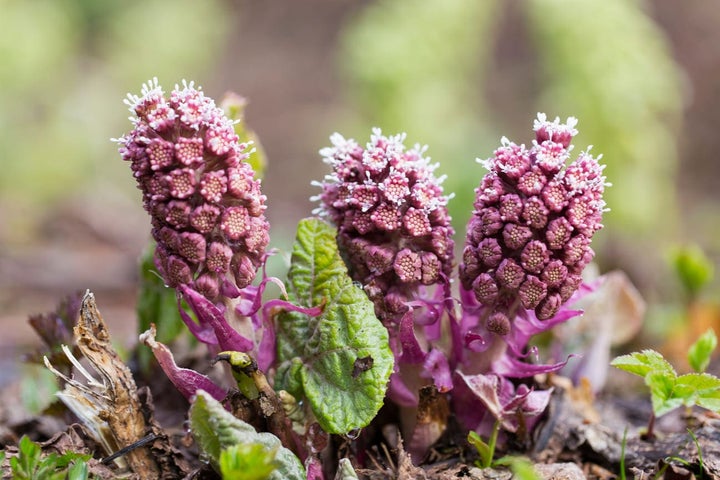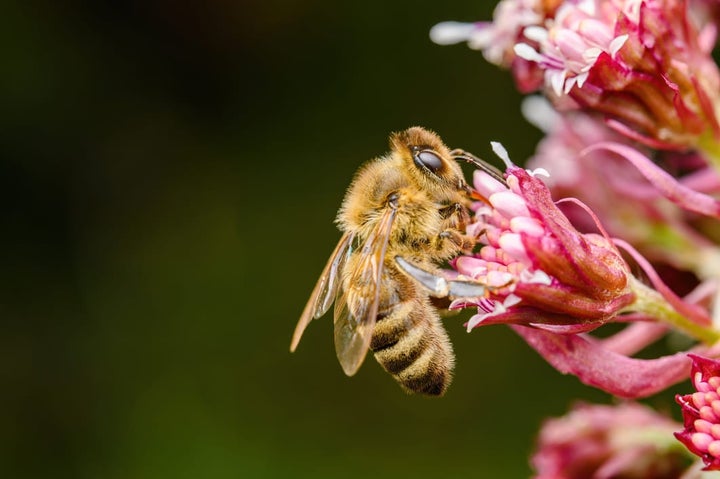
Quick facts
Butterbur’s botanical name is Petasites hybridus and it is native to the UK
Winter heliotrope’s botanical name is Petasites fragrans
Both plants are herbaceous perennials, with new leaves appearing in spring
The flowers of winter heliotrope smell like vanilla and marzipan
If you need to control butterbur or winter heliotrope, non-chemical methods are effective
What do butterbur and winter heliotrope look like?
Distinguishing between butterbur and winter heliotrope isn’t essential as both can be grown as pollinator-friendlyground cover plants. They can, however, be identified by their different size and appearance, helping you decide if you want to keep or remove them.
Butterbur (P. hybridus) has dense clusters of unscented white flowers, marked with shades of pink and purple. These appear in early spring, on sturdy stems up to 40cm (16in) high. Roughly heart-shaped leaves appear soon after. These vary in size, depending on growing conditions, but can reach 1m (3¼ft) across, held on stalks up to 1.5m (5ft) high.


Did you know?
Long before fridges, butter was wrapped in butterbur leaves to protect it and keep it cool, hence its common name. It is also known as bog rhubarb, due to its large leaves and preference for wet soil.
Winter heliotrope (P. fragrans) flowers earlier, from mid-winter to early spring, producing loose spikes of scented, pale flowers with pink and purple colouring, on stems about 20cm (8in) high. Rounded, slightly kidney-shaped leaves appear in spring, generally growing to about 25cm (10in) across, held on stems roughly 20cm (8in) high.


Did you know?
Other species of Petasites include P. albus (white butterbur), P. japonicus (giant butterbur) and P. paradoxus – in some situations these might also be considered weeds.
Are butterbur and winter heliotrope weeds?
Not necessarily – both can serve as useful ground cover plants, with butterbur preferring damp shade and winter heliotrope being more tolerant of dry soils, in sun or shade. Like many other ground cover plants, their spreading habit helps to stabilise soil and prevent erosion, so they can be a good choice for banks and slopes.
Both plants are also great for wildlife, with their winter and early spring flowers providing nectar and pollen for bees at a time when other food sources are scarce. The carpet of leaves provides habitat and shelter for various creatures, including ground-active invertebrates.
However, their spreading habit could make them unwelcome in areas of your garden where they will outcompete or smother smaller plants.
What is a weed?
The term ‘weed’ describes a plant that is growing where it isn’t wanted. Weeds usually thrive in average garden conditions, reproducing and spreading easily. It is up to you to decide what you call a weed and what you choose to retain or remove.
Frequently asked questions about controlling butterbur and winter heliotrope
Here are our answers to your most common questions about dealing with butterbur and winter heliotrope:
How invasive are butterbur and winter heliotrope?
Both plants spread underground by creeping, branching . In good growing conditions a clump can spread quickly, forming a dense carpet. New plants can grow from small sections of rhizome and butterbur can spread along waterways if sections break off and fall into moving water.
The good news is, that as plants rarely spread by seed, owing to the scarcity of female plants in the UK, they don’t tend to pop up all over a garden. An established clump will expand, but its spread can be controlled to stop it getting out of bounds.
Do I need to get rid of butterbur or winter heliotrope?
No – both plants can be valuable ornamentals and are great for your garden wildlife. Growing them in a ‘wild’ or wildlife area, or in their own designated bed, is a great way to boost the of your garden.

However, as both plants are capable of outcompeting and smothering smaller or less vigorous plants, it is a good idea to manage their spread and stop them getting out of bounds.
What is the easiest way to kill butterbur and winter heliotrope?
If you have butterbur or winter heliotrope growing where it is not wanted, there are a few ways to remove it:
- Fork out plants – use a border fork, inserted to its full depth, to lift and remove as much of the root system as possible. Repeated removal of new stems and sections of rhizome will weaken and eventually eradicate plants, particularly winter heliotrope which resents disturbance. This method can also be used around the edge of a clump to curtail its spread. If either are growing among other plants, lift the plants (ideally when ), and remove unwanted Petasites rhizomes before replanting.
- Cut regularly – use a strimmer, brushcutter or mower for large areas. Cutting back new growth regularly will weaken and eventually kill both plants. This is likely to take more than one growing season, but is better for soil health as it limits disturbance.
- Smother plants – cover with a layer of compostable material, such as cardboard, and then a 20cm (8in) thick layer of organic matter, such as or wood chips. A heavy grade of matting could also be used. This will block light and prevent growth, causing the root system to die. The soil will need to be covered for at least two years for this method to be effective.
Top Tip
As plants can regenerate from small pieces of rhizome, it is best not to add roots or rhizomes to your home compost bin – put them in your council green waste bin or take them to a waste recycling site instead.
Should I use a weedkiller?
As non-chemical control methods are effective, even if time-consuming, there is no need to use weedkillers. Butterbur often grows near water, where the use of weedkillers is restricted to prevent contamination and harm to aquatic life.





